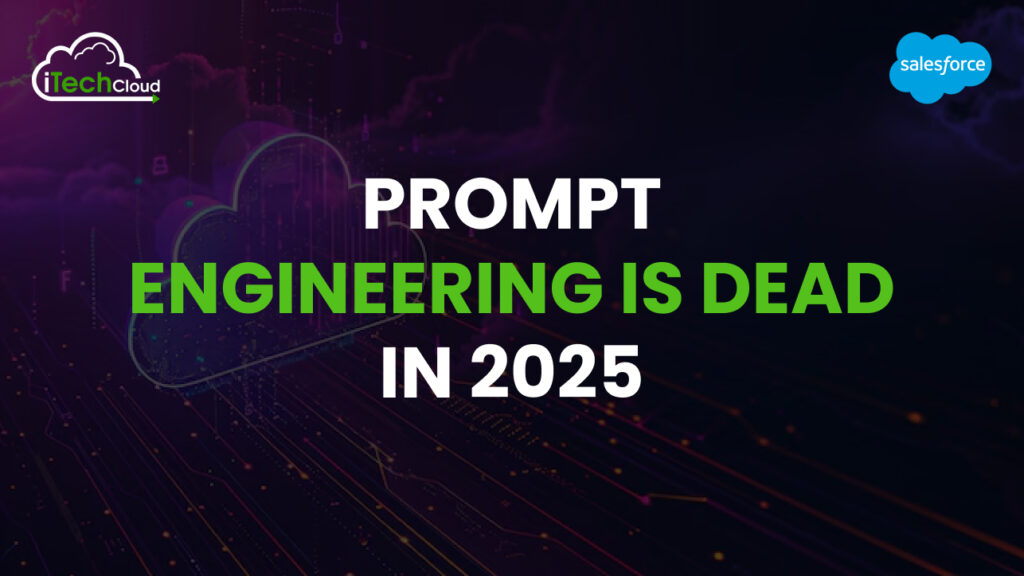Prompt Engineering Is Dead in 2025

Introduction
Prompt engineering, once hailed as the essential skill for interacting with large language models (LLMs), has become obsolete by 2025. What was once a meticulous craft carefully structuring inputs to extract optimal outputs has faded into irrelevance due to rapid advancements in AI autonomy, natural language understanding (NLU), and adaptive personalization.
This blog explores the rise and fall of prompt engineering, the technological shifts that rendered it unnecessary, and what comes next in human-AI collaboration.
Table of Contents
1. The Rise of Prompt Engineering (2020-2024)
Why Prompt Engineering Mattered
Early LLMs (GPT-3, GPT-4, Claude, Gemini) were powerful but highly sensitive to input phrasing. Users quickly realized that
- Vague prompts (“Write a blog post”) produced mediocre results.
- Structured prompts (“Write a 1,200-word technical blog on quantum computing for engineers, citing recent research papers”) yielded high-quality outputs.
This led to:
- Corporate demand for prompt engineers to optimize AI workflows.
- Courses and certifications teaching prompt design.
- “Jailbreaking” techniques (e.g., “Act as an expert physicist”) to bypass model limitations.
The Limitations of Manual Prompting
Despite its utility, prompt engineering had flaws:
- Trial-and-error inefficiency – Users had to iterate prompts to get desired results.
- Lack of generalizability – A perfect prompt for one task often failed in another.
- Over-reliance on user expertise – Not everyone could craft optimal inputs.
2. Why Prompt Engineering Died (2025)
By 2025, several AI advancements eliminated the need for manual prompt crafting:
1. Autonomous AI Agents
Self-refining workflows – Modern AI (e.g., GPT-5, Gemini Ultra) no longer requires step-by-step instructions. Instead, it:
- Asks clarifying questions.
- Iteratively improves responses.
- Chains tasks without human intervention.
- Example:
- 2023: “Write a sales pitch for a SaaS product.”
- 2025: AI autonomously researches the product, generates multiple pitch variants, A/B tests them, and refines based on engagement data.
2. Natural Language Understanding (NLU) Breakthroughs
Context-aware comprehension – AI now understands implicit intent, eliminating the need for rigid prompting.
- Detects tone, audience, and complexity preferences.
- Resolves ambiguities without explicit guidance.
- Example:
- 2023: “Explain neural networks like I’m five.”
- 2025: User says, “Tell me about neural networks,” and AI auto-adjusts explanation depth based on user history.
3. Hyper-Personalized AI Assistants
- Persistent memory – AI retains user preferences across sessions.
- Adaptive communication – Learns whether a user prefers bullet points, summaries, or detailed reports.
- Proactive assistance – Anticipates needs (e.g., “You usually draft reports on Fridays—should I start one?”).
4. Multimodal & Voice-First Interaction
- Decline of text-based prompting – Most interactions now occur via voice or gesture, making rigid text prompts obsolete.
- Real-time dynamic adjustments – AI interprets tone, facial expressions, and vocal cues to refine responses.
3. The New Paradigm: Autonomous, Adaptive AI
Key Features of 2025 AI Systems
Feature 2023 (Prompt Engineering Era) 2025 (Post-Prompting Era) Interaction Style Manual prompting Conversational, proactive Task Execution Single-step responses Multi-step autonomous workflows Personalization None (unless explicitly prompted) Context-aware, memory-enabled Error Correction User must refine prompts. AI self-critiques and improves Output Quality Highly prompt-dependent Consistently high, adaptive
Real-World Impact
- Business: AI autonomously drafts contracts, negotiates terms, and adjusts strategies.
- Healthcare: AI cross-references patient history, symptoms, and research to suggest treatments.
- Creative Work: AI co-writes scripts, designs graphics, and edits videos with minimal input.
4. What Replaces Prompt Engineering?
Emerging Skills for the AI Era
- AI Delegation – Knowing when to let AI act independently vs. when to intervene.
- Ethical Oversight – Ensuring AI aligns with organizational and societal values.
- Integration Expertise – Merging AI with IoT, robotics, and other systems.
- Creative Collaboration – Using AI as a brainstorming partner rather than a tool.
- Bias Mitigation – Auditing autonomous AI decisions for fairness.
Industries Most Affected
- Customer Support: AI handles 90% of queries without human input.
- Content Creation: AI generates first drafts, which humans refine.
- Software Development: AI writes, tests, and deploys code autonomously.
5. Ethical and Societal Implications
Potential Risks
- Job Displacement – Roles like technical writers, junior developers, and customer service reps evolve or diminish.
- Over-Reliance on AI – Reduced critical thinking skills in humans.
- Accountability Gaps – If AI makes a mistake, who is responsible?
Benefits
- Democratization of Expertise – High-quality advice available to all.
- Efficiency Gains – Less time spent on repetitive tasks.
- Enhanced Creativity – Humans focus on big-picture innovation.
Conclusion: Prompt Engineering Is Dead in 2025
While the provocative claim that “Prompt Engineering is Dead in 2025” grabs attention, the reality is more nuanced. As AI models become more intuitive and user-friendly, the need for complex prompt crafting is diminishing. However, the essence of prompt engineering clear communication, intent framing, and strategic guidance remains relevant. It’s not dead; it’s evolving. The future lies in mastering context, creativity, and collaboration with AI, rather than manipulating prompts.

